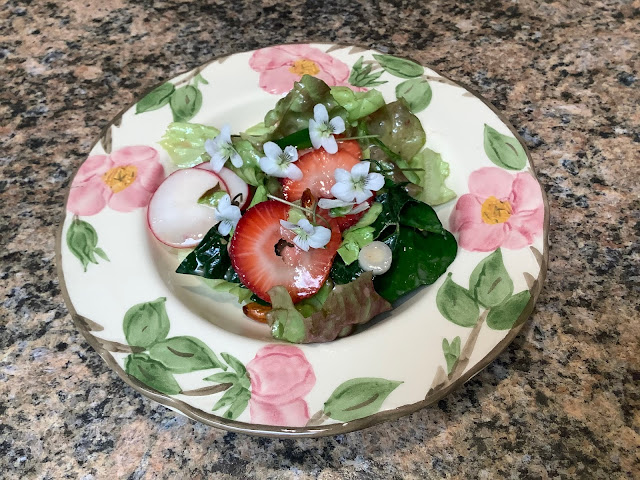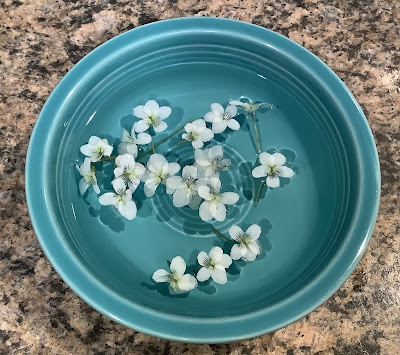
Recipe: Spring strawberry salad with fresh violets
 |
|
As fresh and pretty as spring: Strawberry salad with fresh violets. (Photos: Debbie Arrington)
|
This vibrant spring salad is as flavorful as it is colorful. Both cut crosswise, fresh strawberries and radishes contrast nicely in both taste and texture. They look especially pretty combined with the rich greens of fresh spinach and leaf lettuce. (The variety used in this recipe: Red butterhead.)
The garnish is a conversation starter: Fresh violets. The white and blue varieties of Viola are edible.
Viola alba , the white perennial violet, is native to America’s woodlands. It’s a cast-iron ground cover in low-water gardens. It grows so easily, many gardeners consider it a weed.
If you can’t beat it, eat it. (Just make sure your violets haven’t been exposed to pesticides or herbicides.)
Pick your violets with about ½ inch of stem.
Plunge flowers immediately into ice-cold water. Keep them in cold water until ready to use. Other varieties of Viola may be substituted for violets; the smaller the varieties, the tastier.
 |
|
Put just-picked violets into very cold water to keep
them fresh.
|
Spring strawberry salad with fresh violets
Makes 2 to 4 servings
Ingredients:
Comments
0 comments have been posted.Sacramento Digs Gardening to your inbox.
Food in My Back Yard Series
April 1: Don't be fooled by these garden myths
March 25: Fertilizer tips: How to 'feed' your vegetables for healthy growth
March 18: Time to give vegetable seedlings some more space
March 11: Ways to win the fight against weeds
March 4: Potatoes from the garden
Feb. 25: Plant a fruit tree now -- for later
Feb. 18: How to squeeze more food into less space
Feb. 11: When to plant? Consider staggering your transplants
Feb. 4: Starting in seed starting
Sites We Like
Garden Checklist for week of March 30
Your garden doesn’t mind April showers. Get busy now to enjoy those future flowers.
* Get ready to swing into action in the vegetable garden. As nights warm up over 50 degrees, start setting out tomato, pepper and eggplant transplants.
* From seed, plant beans, beets, cantaloupes, carrots, corn, cucumbers, melons, pumpkins, radishes and squash. (Soak beet seeds overnight in water for better germination,)
* Plant onion sets.
* In the flower garden, plant seeds for asters, cosmos, celosia, marigolds, salvia, sunflowers and zinnias.
* Transplant petunias, zinnias, geraniums and other summer bloomers.
* Plant perennials and dahlia tubers for summer bloom.
* Transplant lettuce and cabbage seedlings.
* April is the last chance to plant citrus trees such as dwarf orange, lemon and kumquat. These trees also look good in landscaping and provide fresh fruit in winter.
* Smell orange blossoms? Feed citrus trees with a low dose of balanced fertilizer (such as 10-10-10) during bloom to help set fruit. Keep an eye out for ants.
* Apply slow-release fertilizer to the lawn.